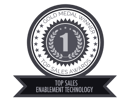
A Brief History of Sales Technology
Sales technology has certainly changed across the decades. From the first Rolodexes to today’s massive, AI-equipped juggernauts of automation with all the bells and whistles, we’ve come a long way.
To celebrate (and evaluate), here’s a brief history for your enjoyment.
Early Tools Were Designed For Record-Keeping
Everyone knows that the Rolodex, invented in 1956, was one of the earliest forms of “CRM” to enter the scene. The Rolodex was a way to manage the dozens and even hundreds of business cards a salesperson might accumulate. It was another thirty years before the Rolodex gave way to new technology.
In 1987, with computers increasingly finding their way into business applications, ACT! came on the scene. ACT! was essentially a Rolodex in digital form. It enabled salespeople to keep track of their contacts, and it also enabled their employers to access that data. This was a mixed blessing for salespeople, who sometimes saw it as an attempt at management to steal their hard work and own the data they themselves collected.
Both the Rolodex and ACT! focused on storing and managing data as their exclusive function. Other platforms came on the scene, following in the footsteps of ACT!, without major breakthroughs until the 1990s.
The Cloud Drove Sales Tech Innovation in the 90s and 2000s
Into the 1990s, record-keeping and data tracking continued to be the primary goals of most sales technology. There were advances enabling managers to analyze and manage the data in new ways, but the next significant transformation occurred when Salesforce came on the scene in 1999.
Salesforce initiated the transition from self-hosted instances of sales software, to a cloud-based subscription model. The advantages of this model included ensuring you always had the most up to date version, not having to maintain servers on your premises, and, importantly, the ability to collaborate in new and exciting ways.
Salesforce quickly rode this wave to become the juggernaut that it is today. However, despite its innovative use of the cloud, Salesforce remained through the 2000s, primarily focused on the same thing the old Rolodexes were: data storage and tracking.
Inbound and the Rise of Content Drove a Whole New Generation of Marketing and Sales Platforms
In 2008, a company called Hubspot joined a now proliferating sea of sales and marketing technologies. Initially promoted as a marketing automation tool, it quickly found its way into every aspect of both sales and marketing, touting a whole new way of selling that aimed to eliminate the need for professional salespeople altogether (at least in their initial marketing.)
Hubspot’s marketing automation platform was only the start. They launched a massive information campaign that claimed you could funnel customers directly to order-takers, by hooking them on your content and moving them through most of the buying journey with automated processes. This may work well in transactional sales, but less so in complex sales.
Sales Technology Proliferated Wildly into the 2010s and 2020s
By the mid-2010s, the world of sales technology was growing exponentially year over year. Salesloft and Outreach entered the scene with email automation platforms that allowed sales teams to set up email cadences that began after sales calls or actions taken by buyers.
Call recording, sales intelligence, sales enablement, sales engagement, automated scheduling, document signing, sales rooms, and more types of technology products entered the market. Many of these technologies focused on automation, data analysis, and efficiency.
As the types of sales technology platforms expanded, so did their use. And as use of these platforms expanded, so did spam. Inboxes overflowed with content marketing, outreach automation, automated sales sequences, and other kinds of broadcasts. Before long, legislation began to grow to try to control this explosion, with limited success.
This proliferation has created a marketplace that is numb to and annoyed by the incoming barrage. And, with all of this new tech, sales effectiveness never quite saw the increase that the technologies promise.
The 2020s Bring the AI Revolution
I don’t have to tell you that the next big revolution in sales software technology has been generative AI. For better and worse, it has become woven into almost every aspect of sales technology, from content creation to email writing, from call transcription to data crunching.
This has had profound impacts on how consumers interact with sales teams and content. One striking example is Hubspot reporting an 80% decline in blog traffic, partly due to customers turning to AI chatbots for information, challenging traditional inbound and SEO marketing approaches.
It has also had profound implications for how salespeople work. Forward-thinking companies quickly enlisted generative AI to help salespeople summarize information, find company materials to share, analyze data, write emails, and perform other tasks at a fraction of the cost of human labor.
This has been a double-edged sword. What AI can produce in efficiency, it can also create in lost connection with the essentially human aspects of sales. It is easy to get carried away and feel that the technology can do everything, but the reality is that it is best suited to support, not replace, human judgment and decision-making.
What Will The Future of Sales Technology Hold?
Of course, no one knows exactly what the future will bring or what technologies will evolve next. But one thing we do know is that, at least for the foreseeable future, AI is here to stay, and companies that learn to use it in effective ways will get ahead of those who don’t.
And this raises the question: What does it mean to use AI effectively?
It’s easy to get caught up in the excitement and expect AI to make everything easier, faster, simpler, and cheaper. But the reality is that AI is a technology, just like every other technology, and it is only as capable as the humans who design, customize, and use it.
It is incredibly good at some things, and terrible at others.
From my perspective, the point is to enhance human and business performance, to drive meaningful customer interactions, not send people into automation hell. And to differentiate your company by connecting buyers with solutions to their real needs, not spamming them with irrelevant content.
The point is to increase effectiveness, not just efficiency.
And so, I close with a question: What are you doing to ensure that you integrate AI in a meaningful, effective manner to support your sales team’s success?

By George Brontén
George is the founder & CEO of Membrain, the Sales Enablement CRM that makes it easy to execute your sales strategy. A life-long entrepreneur with 20 years of experience in the software space and a passion for sales and marketing. With the life motto "Don't settle for mainstream", he is always looking for new ways to achieve improved business results using innovative software, skills, and processes. George is also the author of the book Stop Killing Deals and the host of the Stop Killing Deals webinar and podcast series.
Find out more about George Brontén on LinkedIn







